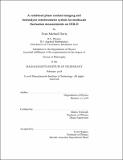| dc.contributor.advisor | Miklos Porkolab. | en_US |
| dc.contributor.author | Davis, Evan Michael | en_US |
| dc.contributor.other | Massachusetts Institute of Technology. Department of Physics. | en_US |
| dc.date.accessioned | 2018-05-23T16:29:23Z | |
| dc.date.available | 2018-05-23T16:29:23Z | |
| dc.date.copyright | 2018 | en_US |
| dc.date.issued | 2018 | en_US |
| dc.identifier.uri | http://hdl.handle.net/1721.1/115666 | |
| dc.description | Thesis: Ph. D., Massachusetts Institute of Technology, Department of Physics, 2018. | en_US |
| dc.description | Cataloged from PDF version of thesis. | en_US |
| dc.description | Includes bibliographical references. | en_US |
| dc.description.abstract | A novel combined diagnostic capable of measuring multiscale density fluctuations that extend from magnetohydrodynamic (MHD) scales to the lower bound of the electron temperature gradient (ETG) mode has been designed, installed, and operated at the DIII-D tokamak. The combined diagnostic was constructed by adding a heterodyne interferometer to the pre-existing phase contrast imaging (PCI) system, both of which measure line-integrated electron-density fluctuations. The port-space footprint is minimized by using a single 10.6 pm CO2 laser and a single beampath. With temporal bandwidths in excess of 1 MHz, the PCI measures high-k (1.5 cm-1 < k +/<kI ; 25 cm-1) fluctuations with sensitivity 3 x 1013 M-2 [square root of] kHz, while the interferometer simultaneously measures low-k (k < 5 cm- 1) fluctuations with sensitivity 3 x 1014 m-2 [square root of]kHz. The intentional mid-k overlap has been empirically verified with sound-wave calibrations and should allow quantitative investigation of the cross-scale coupling predicted to be significant in the reactor-relevant Te ~ Tj regime. The combined PCI-interferometer was operated during an experiment in which the ETG drive a/LT, and the ion temperature gradient (ITG) drive a/LT, were locally modified in an attempt to elicit a multiscale turbulent response. Numerous turbulent branches are observed. In particular, the interferometer measures a low-k electromagnetic mode driven unstable by collisionality, properties consistent with the micro-tearing mode (MTM), and the PCI measures a turbulent mode that exhibits distinct "spectral flattening" when increasing a/LTe relative to a/LTi', hypothesized to be a tell-tale signature of increased cross-scale coupling. Linear-stability analysis and quasi-linear-transport modeling are performed with the trapped gyro-Landau fluid code TGLF, and qualitative agreement with the PCI-measured spectral flattening is obtained. Further, via toroidal correlation with DIII-D's primary interferometer, the measurement of core-localized MHD toroidal mode numbers has been demonstrated. Where comparisons can be made with magnetic probes, the interferometer-measured toroidal mode numbers are typically in good agreement. Unfortunately, the 4 cm major-radial offset between the interferometer beam centers in DIII-D can bias the mode-number measurement, limiting widespread use of this capability until a robust compensation technique is developed. | en_US |
| dc.description.statementofresponsibility | by Evan Michael Davis. | en_US |
| dc.format.extent | 293, [1] pages | en_US |
| dc.language.iso | eng | en_US |
| dc.publisher | Massachusetts Institute of Technology | en_US |
| dc.rights | MIT theses are protected by copyright. They may be viewed, downloaded, or printed from this source but further reproduction or distribution in any format is prohibited without written permission. | en_US |
| dc.rights.uri | http://dspace.mit.edu/handle/1721.1/7582 | en_US |
| dc.subject | Physics. | en_US |
| dc.title | A combined phase contrast imaging and heterodyne interferometer system for multiscale fluctuation measurements on DIII-D | en_US |
| dc.type | Thesis | en_US |
| dc.description.degree | Ph. D. | en_US |
| dc.contributor.department | Massachusetts Institute of Technology. Department of Physics | |
| dc.identifier.oclc | 1036985497 | en_US |
